- Author
- A.N. Other
- Subjects
- WWII operations, History - WW2
- Tags
-
- RAN Ships
- None noted.
- Publication
- December 2018 edition of the Naval Historical Review (all rights reserved)
By Mike Turner and Hector Donohue
Very little has ever been reported about the controlled minefields laid at ports along Australia’s east coast in 1942 as part of Australia’s defence against Japanese invasion. The primary role for controlled minefields became defence against midget submarines after two events in 1942. Japanese midget submarines entered Sydney Harbour on 31 May. The threat of invasion receded after the United States Navy decisive victory at the Battle of Midway on 4-7 June.
Controlled minefields
Controlled minefields are either observation minefields or loop controlled minefields.
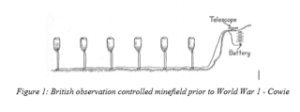
Some of the mines in an observation minefield are fired by a shore control station when a ship is visually observed to be crossing a mine line. The first controlled mines were designed in 1843 by Colonel Colt of revolver fame. The first operational observation minefields were laid during the First Schleswig War in 184 -51, and successfully deterred the Danish fleet from entering Kiel Harbour.
There was concern in Australia in 1877–78 that Australian ports and coastal shipping could be attacked by Russian warships if there was a war between Britain and Russia. The Russian intention to do so in 1878 was confirmed in 1891. Australia’s defences included observation minefields, and the British Mk 3 Electrical Mine was in service. The storage, maintenance and laying of observation minefields was an Army responsibility until they were transferred to the RAN in 1912.
Britain first laid loop controlled minefields in World War 1
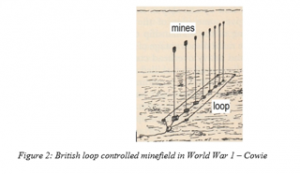
Ground mines, or the sinkers of moored mines, in a loop controlled minefield are enclosed by a loop of electrical cable. In Figure 2 the loop is about 550m by 22 m. When a submarine (or steel-hulled ship) crosses the loop a small current is generated in the loop and deflects an extremely sensitive moving coil galvanometer in a shore control station. This deflection is amplified by a small lamp shining on the galvanometer mirror and observed as a spot of light moving across a screen in one direction and then in the reverse direction (a ‘swing’). Mines are fired when a ‘swing’ indicates that a submarine is over the loop. A guard loop to seaward alerts the control station to the approach of a submarine.
Individual controlled mines can be laid in rivers, canals or narrow channels and controlled by visual observation, for example as shown in the schematic in Figure 3.
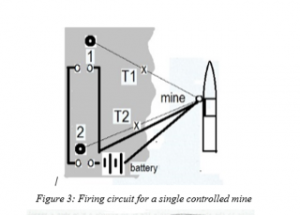
There is a firing key at shore stations 1 and 2. The mine detonates when both keys are closed and the battery is connected to the mine detonator. Each shore station has a transit line to the mine using a transit marker, T1 or T2. A key is closed whilst a designated section on a ship is on the mine transit line, the designated section in this example being the port side of the ship’s superstructure denoted by a heavy line. Figure 3 is a limiting case where both keys are about to be closed. Single controlled mines were laid by the Viet Cong in rivers and canals in South Vietnam during the Vietnam War. When Eastern Mariner (ex-minelayer HMAS Bungaree)was wrecked by a mine in the Saigon River on 26 May 1966 the mine was almost certainly such a mine.
Table 1: British controlled mines laid by the RAN
| L Mk 2 | L Mk 3 | L Mk 4 | |
| Type | ground or moored | ground | ground |
| Diameter | 1.02 m | 0.79 m | |
| Charge weight | 227 kg | 909 kg | 227 kg |
| Mine weight | 505 kg | 318 kg | |
| Sinker weight | 952 kg | (no sinker) | 446 kg |
| Total weight | 1457 kg | 1629 kg | 764 kg |
The L MK 2 moored mine became a ground mine when married to its sinker. On 21 March 1942 the Admiralty requested storage at the RAN Mine Depot at Swan Island for 1200 controlled mines – 600 L Mk 2, 300 L Mk 3 and 300 L Mk 4.
RAN observation minefields
In 1941 Australia did not have any controlled mines, and the Naval Board requested the Torpedo School, Flinders Naval Depot to undertake experiments related to observation minefields. These experiments were under the supervision of LCDR R B C Hutchison RN, who had relevant experience in Northern Ireland. It was intended that materials would come from local sources, including large quantities of heavy lead-covered cable. These experiments were successfully completed by January 1942, using the charges from Mk XIV moored mines and Mk VII depth charges.
By April 1942 the Director of Military Operations had selected thirteen areas requiring anti-invasion minefields. Botany Bay, Port Stephens and Broken Bay were of particular importance, since they offered flank access to vital centres.
Priorities for ports were reviewed following the Japanese midget submarine attack at Sydney on 31 May/1 June 1942, and the first minefield was laid at Newcastle in June as described later. Like the Newcastle minefield the other three priority minefields in June 1942 were designed for protection against midget submarines, and were:
- Townsville
- Cairns
- Port Phillip
On 4 August 1942 Navy informed Army that the minefields at Newcastle, Townsville and Cairns had been completed, and anti-invasion minefields at Botany Bay, Broken Bay and Port Stevens were underway. The minefield for Port Phillip had been cancelled, since Melbourne and Geelong would now be covered by an Indicator Loop System inside Port Phillip Heads from Portsea to Swan Island. There was also an Indicator Loop System at Sydney Heads.
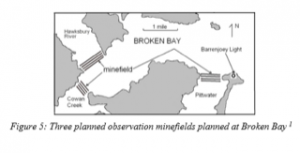
Minefields normally had four parallel mine lines. At Broken Bay anti-invasion minefields were planned for Pittwater, Hawksbury River and Cowan Creek. Mining stations were established at Hungry Beach and Juno Head (aka Juno Point). Presumably the Hungry Beach minefield was between Hungry Beach and Juno Head, and the Cowan Creek minefield was cancelled. Presumably the Pittwater minefield was also laid.
The areas eventually provided with observation minefields were:
- Newcastle (completed before code names were assigned)
- Townsville (Operation PEARL)
- Cairns (Operation RUBY)
- Broken Bay (Operation OPAL)
- Botany Bay (Operation TOPAZ)
- Port Stephens (Operation DIAMOND)
Observation minefields were manned by Navy personnel working in close co-operation with the Army.
RAN loop controlled minefields
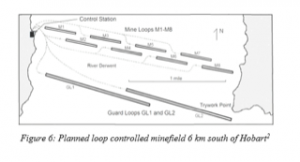
A loop controlled minefield had 128 mines. A ‘station’ had eight electrical cable loops (‘minefield loops’), each surrounding a mine line of sixteen mines. The protected width was about two miles, as in Figure 6. There were also two loops of electrical cable to seaward (‘guard loops’) to alert the control station to the imminent arrival of a submarine at the minefield.
In March 1942 the Admiralty sent ACNB plans for loop controlled minefields at Hobart, Sydney and Port Darwin. In May 1942 ACNB advised the Admiralty that there was no current requirement for minefields at Hobart and Sydney, and the Admiralty agreed. Indicator loops were laid at Port Darwin instead of controlled mines.
In September 1942 it was intended that a station be laid at Port Moresby as soon as the necessary laying arrangements could be made with the Royal Navy, however it was cancelled following a joint RAN/USN meeting on 26 January 1943. Four minefield stations were shipped to Australia, but in the event were never used operationally
- Station Numbers 78 and 79 were held in store at Sydney.
- Station Number 70 was used for training at Flinders Naval Depot.
- Station Number 77 was held at Brisbane as a spare for Station Numbers 57 and 67 laid by the Royal Navy at Brisbane in May and June 1942 (as described later).
Loop controlled minefields at Brisbane
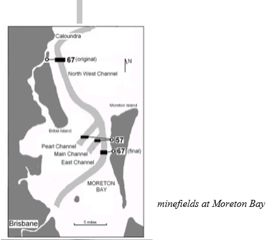
Brisbane was an important naval port which included a very large base for USN submarines, and was the only Australian port protected by loop controlled minefields. Two RN loop controlled minefields (originally intended for Hobart) were laid in 1942 to protect Moreton Bay. In 1944 the minefields were primarily for use against submarines, however they were to be used against cruisers or larger vessels if shore defences could not cope with them. Engagement parameters were established so that if a surface craft was visible above a loop its mines could only be fired if no doubt existed regarding the hostile nature of the vessel. If no surface craft was visible the mines could be fired unless, due to low visibility or failure of searchlights, the absence of a surface craft could not be established beyond all reasonable doubt.
The two loop controlled minefields were
- Station 67, originally laid as the North West Channel minefield, then re-laid as the East Channel minefield.
- Station 57 laid as the Main and Pearl Channel minefields.
The two minefields were laid in May and June 1942 by the Laying Vessel HMS AlseywithHMS Atreus as Base Ship (under the command of Captain J D Campbell RN). Each minefield had eight mine loops with sixteen L Mk 2 mines per loop. Operation DUNCAN was the laying of Station 67 as the North West Channel minefield. All mines were L Mk 2 mines laid as ground mines. The minefield was laid in rough weather from 19 to 30 May, and all loops were tested on 30 May by Alseysteaming over them. On 10 September the survey ship HMAS Bangalowreported on her investigation of faults in this minefield. Eight days later Navy Office advised it was intended that this minefield be recovered and re-laid as a second line off Cowan Cowan in the East Channel. Minelaying Operation EDWARD was the laying of Station 57 as the Pearl and Main Channel minefields from 6 to 19 June, and L Mk 2 mines were laid as both ground mines and moored mines.
The control station for Station 67 (RAN Station Number 2) was initially on Bribie Island, then at Tangalooma on Moreton Island. Station 57 was controlled from Cowan Cowan on Moreton Island (RAN Station Number 3).
Maintenance and recovery of controlled minefields
HMA Ships Bermagui, Gippsland and Uralba were classed as ‘minefield tenders’ responsible for the maintenance of controlled minefields. Bermagui andGippslandhad been built before World War I, whereas 603-gross tons Uralba was requisitioned as a new vessel on 13 August 1942 and commissioned on 23 November 1942. Uralba had been selected as a minefield tender well before she was requisitioned, and appears to have played the leading role as a minefield tender.
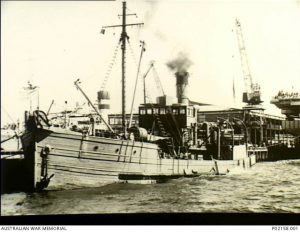
Bermagui was a requisitioned 402-gross ton steamer commissioned on 11 December 1939. and was an auxiliary minesweeper at Newcastle and Adelaide until 12 February 1943. Approval to convert her to a minefield tender was given in March 1943, and she was recommissioned as such on 4 January 1944. She appears to have only been tasked as a minefield tender in January and February 1944. Gippsland was a 143-gross tons requisitioned steamer and laid the observation minefield at Newcastle in 1942 and worked on the Botany Bay minefields in 1943.
Tending minefields included mine loop replacement, for example Uralba relaid Mine Loop No. 2 at Brisbane on 19 December 1943 as Operation HARRY. By March 1945 all observation minefields had been removed with the exception of Newcastle, and the removal of Stations 57 and 67 at Brisbane was nearing completion.
Minefield at Newcastle
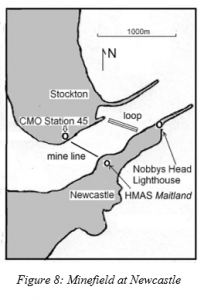
This minefield was an ad hoc controlled minefield, being neither an observation minefield nor a standard controlled minefield. There was a loop around the only mine line to indicate when a submerged submarine was passing over the mine line. The mines are reported as having a height of only 69 cm above the sea bed, so would have been L Mk 3 ground mines. (The depth of water was 7.9 m, and even with the L Mk 3 mine the clearance for deep draught vessels was very marginal). An Indicator Loop acted as a guard loop to alert the staff controlling the mines. The three legs for the loop were 45m apart.
Small concrete bunker huts for Mining Station 45 at Stockton were installed by 18 June 1942. Two days later a 400 m long mine line of 12 mines in eight ‘groups’ was installed by HMAS Gippsland. The minefield was operational on 26 June 1942, and the cable for the three-legged Indicator Loop was laid by Gippsland on 17 August 1942.
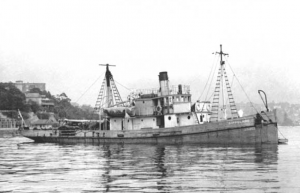
Things that go bump in the night
The OIC of Mining Station 45 in January 1943 was LEUT Alfred Pett RANVR, HMAS Maitland. He was mobilised on 20 March 1942 for mine operations, and completed a Bomb Mine Disposal (BMD) course at Flinders Naval Depot in December 1942.
On the night of 18/19 January 1943 LEUT Pett returned from Newcastle just before midnight to find that the control hut was keeping alarm watches due to submarine activity off the NSW coast. (On 18 January the Japanese submarine I-21was near Sydney when her torpedoes sank the freighter Kalingooand badly damaged the tanker Mobilube). He woke the duty officer on the bed in the control hut and they went to the Wardroom. Pett then checked the minefield circuits in the dark (using a torch to avoid impairing the night vision of the lookout sailor) and without the wireman who was present in the depot at the time. (It was SOP for the Officer of the Watch to conduct a daily check of the firing circuits with the wireman, and this had been done on the forenoon of 18 January). He was unaware that he had accidentally knocked the main firing switch to its ON position. Mine group number 4 was accidentally fired at about 0030 when he re-inserted its safety fuse on completion of testing. The loud explosion was not reported in the Newcastle Herald, presumably due to wartime censorship.
Each mine had the equivalent of 1180 kg TNT, the equivalent of seven Mk 7 depth charges. In the depth of water of 8 m the gas bubbles would have vented and generated airborne shock waves (air blast). The air blast pressure at buildings from the two or three mines in group 4 would have been of the order of 20 Pa, the pressure for a nearby thunderclap. Glass panes in windows require an overpressure of 1000 to 1500 Pa for breakage. The remainder of a building is more robust, and buildings would not have been damaged by the air blast from group 4. The explosion would also have generated seismic ground waves, but it is unlikely that they damaged buildings. Damage to buildings at HMASMaitlandwas not reported at a Board of Inquiry.
The Board of Inquiry found that this weekly test at midnight during an alarm was unnecessary and Lieutenant Pett ‘was grossly careless in carrying out a test’. Pett was transferred to HMAS Magnetic (Townsville) on 22 March 1943 as Rendering Mines Safe (RMS) and BMD officer. In April 1943 the Director of Ordnance, Torpedoes and Mines recommended that ‘if his services are to be retained I recommend that he be transferred from the C/MO branch to some position where he cannot endanger the lives of himself or others.’ Director of Naval Reserves and Naval Reserves Mobilizationrecommended that he be demobilised, however his appointment was not terminated until 28 October 1945.
References
Bould, Andrew, ‘SS Gippsland-our biggest ship’, The PMM Journal, Issue 1, June 2015.
Cowie, JS, Mines, minelayers and minelaying, Oxford University Press, London, 1949.
Explosive blast
<https://www.fema.gov/media-library-data/20130726-1455…/fema426_ch4.pdf> (22July 2018)
Gill, GH, Royal Australian Navy 1942 – 1945, Australian War Memorial, Canberra, 1985.
HMAS Bungaree- Royal Australian Navy, <www.navy.gov.au The Fleet › Ships, Boats & Craft> (20 May 2018).
Kitson, Michael, ‘An attack on Melbourne: a case study of the defence of Australia’s major ports in the early 1890s’, Journal of the Australian War Memorial, number 35, December 2001.
Mines and booby traps used by the Viet Cong in South Vietnam, US Army, 1965.
<www.army.gov.au/…/min_bay_do_viet_cong_mines_and_booby_traps_used_>(20 May 2018).
National Archives of Australia (NAA): MP 1049/5, 1924/4/741.
NAA: MP 1049/1, 1918/0523 (component 4)
Pett, Alfred, Record of service card, NAA: A 6769, <recordsearch.naa.gov.au> (16 August 2014).
Research of back issues of theNewcastle Heraldby Dr Pamela Harrison in May 2018.
Seismic velocity –SEG Wikihttps://wiki.seg.org/wiki/Seismic_velocity(29 July 2018)
Turner, Mike and Hector Donohue, Australian minesweepers at war, Sea Power Centre-Australia, Canberra, 2018.
Walding, R, Newcastle Harbour Defences-Indicator Loops<http://indicatorloops.com/newcastle.htm> (16 May 2018).




